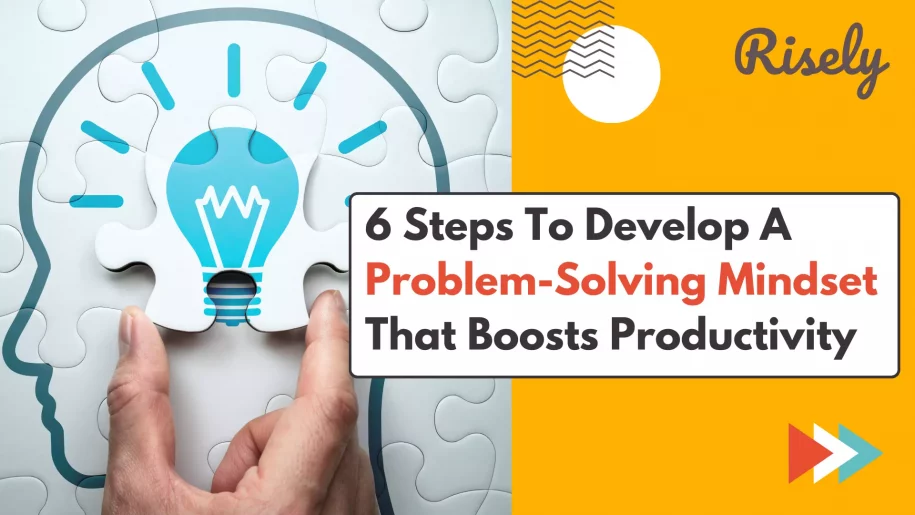6 Steps To Develop A Problem-Solving Mindset That Boosts Productivity
As a manager, you understand your problem-solving ability is critical for success. Whether dealing with a difficult employee, meeting a tight deadline, or navigating a complex project, effectively identifying and addressing challenges is essential to meeting your objectives. But how does one develop a problem-solving mindset? It’s not just about having the right skills or knowledge for many managers; it’s also about approaching problems with the right mindset. In this blog, we will look at the problem-solving mindset and how it can help you overcome common workplace challenges, as well as practical steps for developing and maintaining this important skill. This blog will allow you to approach problems with confidence and creativity. Whether you’re a manager or simply looking to improve your problem-solving skills, this blog will provide valuable insights and tips to help you approach challenges confidently.- 6 Steps To Develop A Problem-Solving Mindset That Boosts Productivity
- Other Related Blogs
What is a problem-solving mindset?
A problem-solving mindset is a way of thinking that enables people to approach problems proactively and productively, looking for solutions rather than focusing on the issues themselves. In the workplace, managers who have a problem-solving mindset are better at seeing problems, coming up with and implementing solutions into practice, and motivating their team to do the same.Problem-controlled approach vs. Problem-solving approach
Problem-controlled and problem-solving approaches are two ways to approach a problem or challenge. The problem-controlled approach involves identifying the problem and controlling or minimizing its impact. This approach does not involve finding a solution to the problem but rather seeks to limit the negative consequences of the problem. For example, a company experiencing a shortage of raw materials due to a natural disaster may take a problem-controlled approach by implementing contingency plans to reduce the impact on production rather than seeking to solve the problem by finding alternative suppliers or developing new products. On the other hand, the problem-solving approach involves actively seeking a solution to the problem. This approach consists of identifying the problem’s root cause, generating and evaluating alternative solutions, and implementing the best solution. For example, a company experiencing a decline in sales may take a problem-solving approach by analyzing market trends, customer needs, and competitive factors to identify the root cause of the decline and then develop and implement a strategy to improve sales. The key difference between the problem-controlled approach and the problem-solving approach is that the former focuses on minimizing the impact of the problem, while the latter focuses on finding a solution to the problem. While the problem-controlled approach may be appropriate in some situations, the problem-solving approach is generally preferred as it addresses the root cause of the problem and can lead to more sustainable solutions.Benefits of a problem-solving mindset
- Better decision-making: A problem-solving mindset helps managers analyze problems more effectively and generate various possible solutions. This leads to more informed decision-making, which is critical for effective leadership.
- Improved productivity: By addressing problems proactively, managers can prevent potential obstacles from becoming major issues that impact productivity. A problem-solving mindset can help managers to anticipate and prevent problems before they occur, leading to smoother operations and higher productivity.
- Enhanced teamwork: Encouraging a problem-solving mindset among team members fosters a culture of collaboration and encourages open communication. This can lead to stronger teamwork, as team members are more likely to work together to identify and solve problems.
- Improved morale: When managers take a proactive approach to problem-solving, they demonstrate their commitment to their team’s success. This can improve morale and build trust and respect between managers and team members.
- Better outcomes: Ultimately, a problem solving mindset leads to better outcomes. By effectively identifying and addressing problems, managers can improve processes, reduce costs, and enhance overall performance.
6 steps to develop a problem-solving mindset
- Acknowledge the issue: Instead of avoiding or dismissing the problem, the first step in adopting a problem-solving mindset is to embrace it. Accept the problem and commit to trying to find a solution.
- Focus on the solutions: Shift your attention from the problem to the solution by concentrating on it. Then, work towards the result by visualizing it.
- Come up with all possible solutions: Create a list of all potential answers, even those that appear unusual or out of the ordinary. Avoid dismissing ideas prematurely and encourage creative thinking.
- Analyze the root cause: After coming up with a list of viable solutions. Finding the fundamental reason enables you to solve the problem and stop it from happening again.
- Take on a new perspective: Sometimes, a new viewpoint might result in game-breakthrough solutions. Consider looking at the problem differently, considering other people’s perspectives, or questioning your presumptions.
- Implement solutions and monitor them: Choose the best course of action, then implement it. Keep an eye on the findings and make changes as needed. Use what you learn from the process to sharpen your problem-solving skills.

Characteristics of a manager with a problem-solving mindset
- Positive attitude: A problem-solving manager approaches challenges with a positive and proactive mindset, focused on solutions rather than problems.
- Analytical thinking: A problem-solving manager breaks down complex challenges into smaller, more manageable pieces and identifies the underlying causes of difficulties because of their strong analytical skills.
- Creativity: A manager with a problem solving mindset think outside the box to solve difficulties and problems.
- Flexibility: A manager with a problem-solving mindset can change their problem-solving strategy depending on the circumstances. They are receptive to new ideas and other viewpoints.
- Collaboration: A manager who prioritizes problem-solving understands the value of collaboration and teamwork. They value team members’ feedback and are skilled at bringing diverse perspectives together to develop creative solutions.
- Strategic thinking: A problem-solving manager thinks strategically, considering the long-term consequences of their decisions and solutions. They can balance short-term fixes with long-term objectives.
- Continuous improvement: A problem-solving manager is dedicated to continuous improvement, always looking for new ways to learn and improve their problem-solving skills. They use feedback and analysis to improve their approach and achieve better results.
Other Interesting Reads
Problem-solving mindset examples for managers
- A manager listens actively to a team member’s concerns and identifies the root cause of a problem before brainstorming potential solutions.
- A manager encourages team members to collaborate and share ideas to solve a challenging problem.
- A manager takes a proactive approach to address potential obstacles, anticipating challenges and taking steps to prevent them from becoming major issues.
- A manager analyzes data and feedback to identify patterns and insights that can inform more effective problem-solving.
- A manager uses various tools and techniques, such as brainstorming, SWOT analysis, or root cause analysis, to identify and address problems.
- To inform about problem-solving, a manager seeks input and feedback from various sources, including team members, stakeholders, and subject matter experts.
- A manager encourages experimentation and risk-taking, fostering a culture of innovation and creativity.
- A manager takes ownership of problems rather than blaming others or deflecting responsibility.
- A manager is willing to admit mistakes and learn from failures rather than become defensive or dismissive.
- A manager focuses on finding solutions rather than dwelling on problems or obstacles.
- A manager can adapt and pivot as needed, being flexible and responsive to changing circumstances or new information.
Conclusion
Finally, developing a problem solving mindset is critical for managers who want to succeed in today’s constantly changing workplace. Managers can improve decision-making, productivity, teamwork, innovation, and morale by embracing challenges and approaching problems with a solution-focused mindset. Developing a problem solving attitude, on the other hand, can be difficult and time-consuming. Nevertheless, managers can develop the skills and attitudes required to effectively navigate the challenges and obstacles in their work by following the tips outlined in this blog and remaining committed to continuous learning and improvement. So, the next time you face a challenge, take a deep breath, embrace it, and use your problem-solving mindset to overcome it. With time and practice, problem-solving will become more than just a skill but a way of life to help you achieve your goals and succeed as a manager.Are your problem solving skills sharp enough to help you succeed?
Find out now with the help of Risely’s problem-solving assessment for managers and team leaders.
Frequently asked questions
Do I have a problem-solving mindset?
If you approach problems with a proactive and solution-focused attitude, actively seek out new information and perspectives, and are willing to adapt and learn from failures, then you likely have a problem-solving mindset.
What is a growth mindset for problem-solving?
A growth mindset for problem-solving is the belief that challenges and problems can be opportunities for growth and learning. Those with a growth mindset are open to feedback and new perspectives, embrace challenges, and view failures as opportunities for improvement and learning.
What is problem mindset vs. solution mindset?
A problem mindset is focused on identifying and defining problems, often dwelling on the negative aspects of a situation. In contrast, a solution mindset is focused on identifying and implementing solutions to problems, taking a proactive and optimistic approach to challenges.
What is a problem-solving attitude?
A problem-solving attitude is a positive and proactive approach to addressing challenges and obstacles. Those with a problem-solving attitude are willing to take ownership of problems, seek new information and perspectives, and actively work to identify and implement solutions. They also view failures and setbacks as opportunities for growth and learning rather than sources of frustration or defeat.
Other Related Blogs
Top 15 Tips for Effective Conflict Mediation at Work
Top 15 Tips for Effective Conflict Mediation at Work As a manager or leader, you might be familiar with the conflicts that arise in the workplace. It’s not always easy…
Top 10 Games for Negotiation Skills to Make You a Better Leader
Top 10 Games for Negotiation Skills to Make You a Better Leader Negotiation skills are essential in today’s workplace and can be honed through various methods. One fun and effective…
Manager Effectiveness: A Complete Guide for Managers in 2024
Manager Effectiveness: A Complete Guide for Managers in 2024 Manager effectiveness is everyone’s favorite buzzword. But the road to achieving it is trickier than it looks like! While manager effectiveness…
5 Proven Ways Managers can Build Collaboration in a Team
5 Proven Ways Managers can Build Collaboration in a Team In today’s fast-paced world, team collaboration is the key to success. But, not all workplaces are conducive to collaborative teams.…


